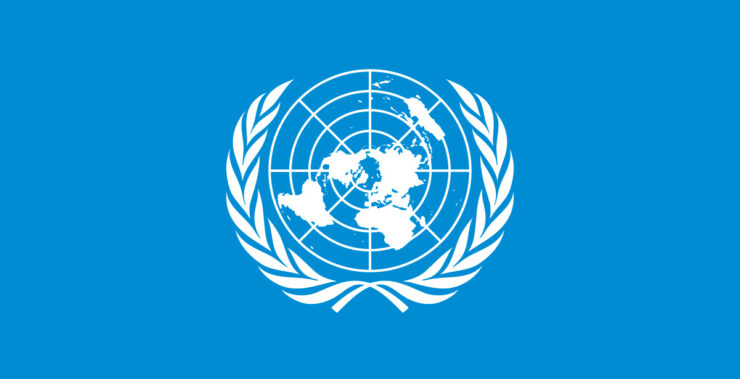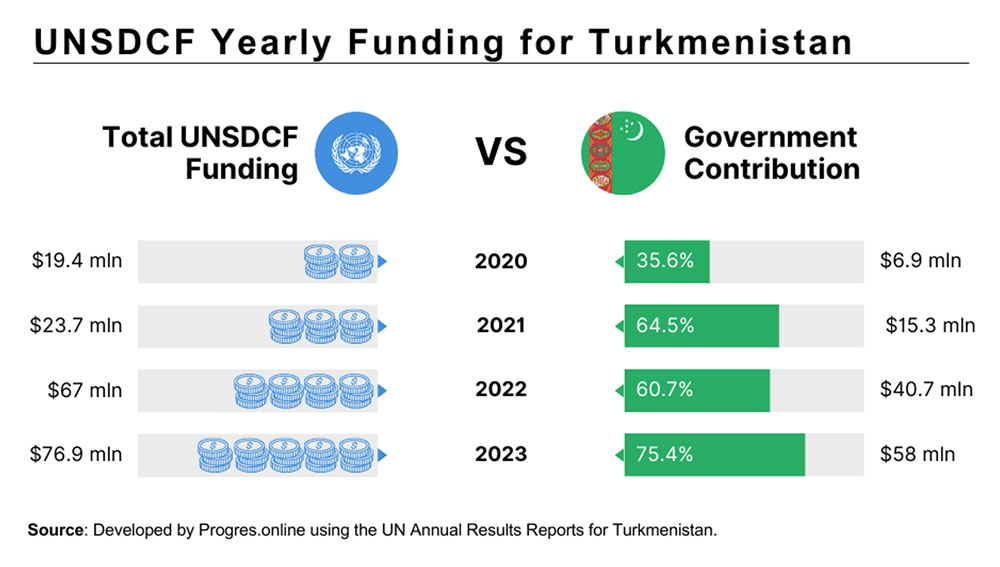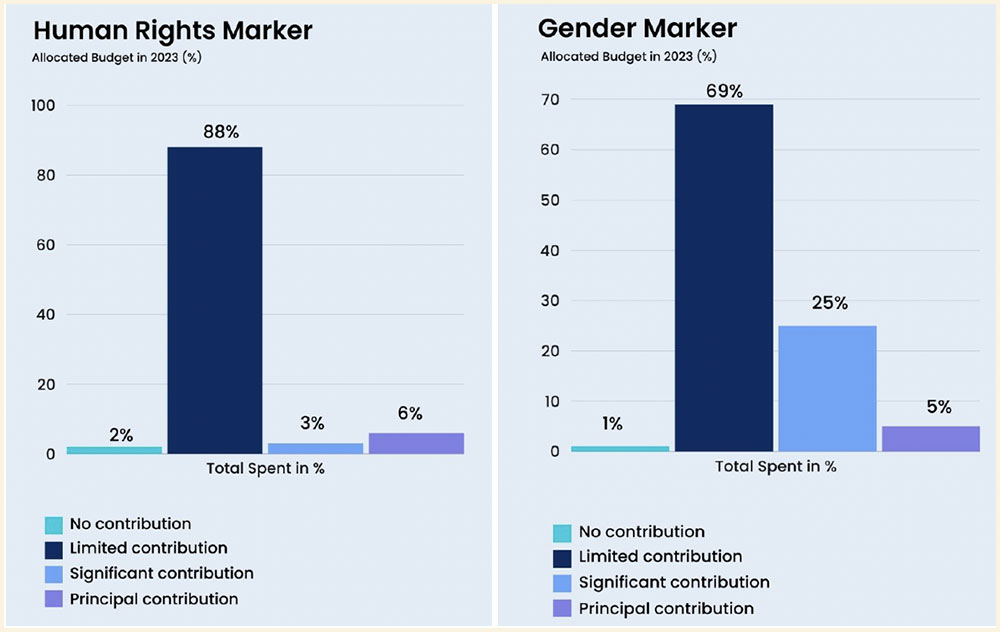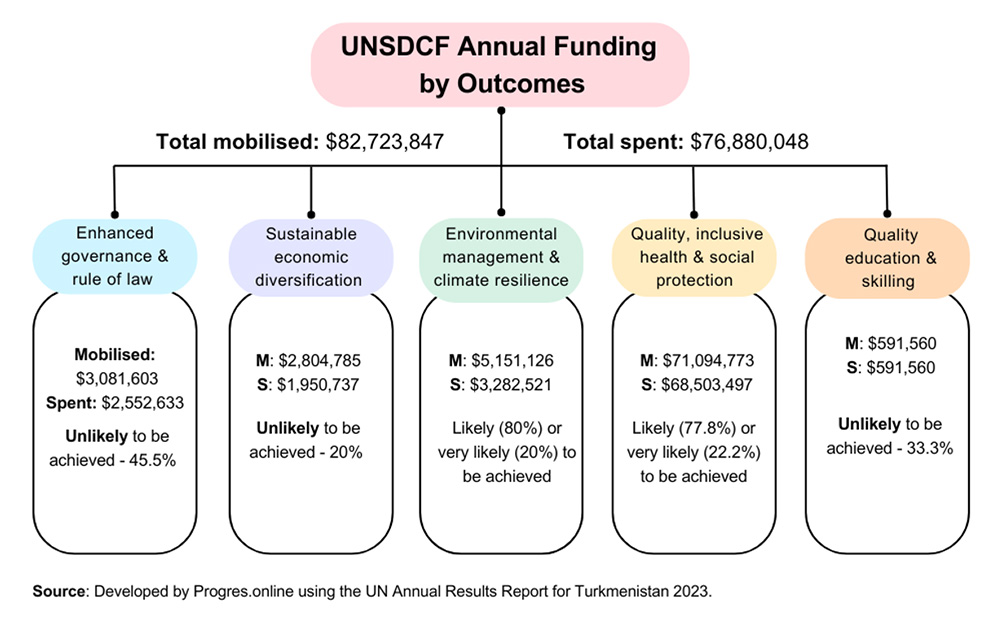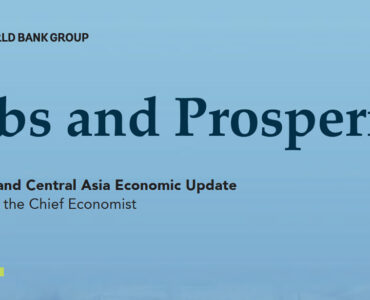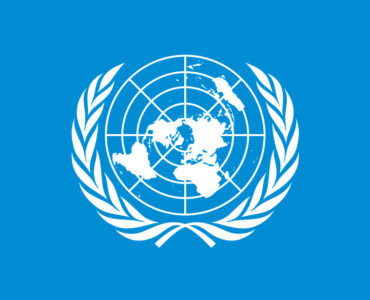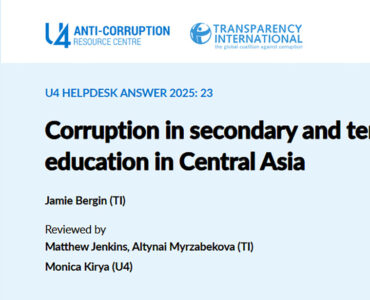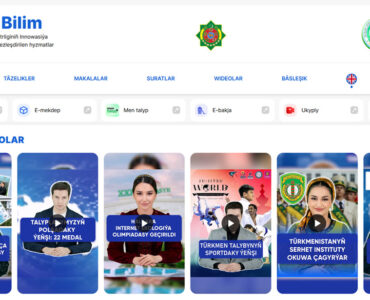Turkmenistan sees no progress in its national institution building efforts, based on Progres Foundation’s analysis of UN Annual Results Report 2023.
The United Nations Country Team for Turkmenistan (UNCT) published its Annual Results Report for 2023 summarizing the progress made by the UN and its partners in supporting Turkmenistan to achieve its national priorities and the Sustainable Development Goals (SDGs). Just like the Annual Report from 2022, which has been analyzed here, this report is also not available in the Turkmen language, and it has some of the same shortcomings which we address below.
This year’s report provides a bit more substance and points out sensitive development challenges facing Turkmenistan. These include human rights, inclusivity and participation. One of the initiatives implemented by the UN is 16 days of activism to fight violence against women. The UN hopes that these events “send a strong message to the government on the need to make concrete steps to implement its commitments under UN conventions and International Declaration of Human Rights”.
For our readers who want to understand what and how the government of Turkmenistan reports on its state obligations under various international treaties we suggest visiting the UN Treaty Body Database.
The UN supports the government of Turkmenistan in achieving its development priorities in line with the Cooperation Frameworks 2021-2025 and SDGs. The United Nations Country Team for Turkmenistan (UNCT) consists of 19 UN specialized agencies, funds and programs. Despite being signatories to the United Nations Sustainable Development Cooperation Framework (UNSDCF), two UN entities – the United Nations Office for Project Services (UNOPS) and the United Nations Office for Disaster Risk Reduction (UNDRR) closed their offices in Turkmenistan because of completion of their projects in 2022 and lack of funding for further programming.
Some of the shortcomings of the report include the following:
- Absence of research – no research or study came out as a result of the UN’s engagement with the government agencies in Turkmenistan in various areas. There is no allocated funding for research, study or needs assessment by the United Nations in Turkmenistan.
- Limited public communication – none of the outputs and the data shared in the report are online and publicly available. They are not shared in the state media, on the websites of the relevant ministries or the State Statistical Committee. Likewise, none of the materials developed under the UN engagement such as the first ever alternative report surveying 250 children from across Turkmenistan was not made available to the public. While the report mentioned several government institutions and public associations as UN national partners, none of their websites were shared.
- Lack of independent project monitoring and evaluation – there is no independent assessment of the impact of the UN projects and programs and effectiveness on the use of funds. The government of Turkmenistan covers the bulk of the funding needs. However, it is unclear if these public resources are efficiently used and what is the impact of these spending. Meanwhile, surveys and reports produced as part of the UN’s engagement with the government agencies are not made public.
- Lack of reliable and detailed data – in the absence of reliable data it is unclear how the UN and government decide on priority areas, target groups, spending goals and types of interventions. Without data it is impossible to understand the scale of the problems. The report also indicated that statistics was a significant and continued problem, both due to unavailability and inaccessibility of data including absence of disaggregated population data and gaps in Cooperation Framework outcome and output indicators.
- Limited engagement of civil society organizations – the UNCT have worked with several nonprofit organizations. However, they are mainly government associated organizations (GONGOs) and their activities rarely extend beyond the capital city. Most of them do not have any online presence (websites, contact information) and they do not share information on common projects they implement with the UN or the results of their projects. Meanwhile, it is impossible to register and operate an independent nonprofit organization in Turkmenistan.
- Not addressing the underlying issues – there is a lot of emphasis in the report on digital resources, ranging from digital public services, and digital inventory for greenhouse emissions to digital educational resources for teachers and online resources for parents. However, the more urgent and challenging issue is the lack of stable, affordable and free Internet, especially in the remote areas of Turkmenistan. While the various UN entities communicate about their activities online on platforms like Instagram, outside of Ashgabat city very few people can access the Internet while having to rely on VPN to access blocked sites.
- Serious risks in achieving the defined priority areas – as the report mentions the potential obstacles to achieving development goals include insufficient expertise of local professionals, limited inter-ministerial coordination, inadequate data availability, insufficient data usage for policy making, slow pace of decision making and approval of joint programs/activities and challenges related to scarcity of donor funding and government cost-sharing. These challenges seriously impede the UN’s ability to effectively implement SDG projects.
- Lack of disaggregated population census data – while the UN refers to the publication of census-2022 preliminary results and making the National SDGs database publicly available as breakthroughs, these are basic data and information. After two years of conducting the census, the detailed results are still not public. While the government promised to share disaggregated data in 2024, we are yet to witness if they actually fulfill this promise.
- Absence of COVID-19 information – although many Turkmen households were impacted by the pandemic, neither the government nor the UN entities have ever confirmed the existence of COVID-19 or the scale of the socio-economic consequences. It is important to note that the UN has not called on the government to acknowledge and report COVID-19 statistics.
- Accepting government data on its face value – the UN report highlights that “based on the census-2022 data and country’s GDP growth estimates, Turkmenistan remained an upper-middle income country, with potential implications of reduced Official Development Assistance (ODA) flows and a narrowing donor base”. Given this the Turkmen government committed to mobilize its internal resources to deliver on national development priorities. However, as we have analyzed in an earlier article, the World Bank should review Turkmenistan’s income categorization primarily because of the dual exchange rate which inflates GDP growth data.
A few positive steps
There are several positive aspects about the report that are worth mentioning. The UN has acknowledged the absence and the need for a national poverty line to better identify those in need. However, the National SDGs database, claims that Turkmenistan has achieved “no poverty” status. It is impossible to eliminate something if you do not measure it first.
The report also highlights several achievements of UNTC as a result of their years long advocacy work in Turkmenistan.
- The government, for the first time since 1995 released preliminary census data from 2022. While the government promised to publish disaggregated data, it has not happened yet.
- The UN worked with the government to produce the 2023 Voluntary National Review (VNR), which had much more and better quality data and analysis on the SDG progress compared to the earlier 2019 report. Similarly, the State Statistical Committee finally published SDG data for 130 indicators on their website making it available to the public in the Turkmen language. The VNRs 2019 and 2023 are also available in the Turkmen language.
Funding levels
In total nearly $83 million was mobilized in 2023 of which the government of Turkmenistan contributed over $58 million. The next two biggest contributing partners were the Global Fund ($8.8 million) and the Global Environment Facility ($3 million). As illustrated in the chart below, the funding mobilized to implement the priorities of sustainable development of Turkmenistan has increased over time, from $23 million in 2021 and expected to reach $100 million in 2024. The share of government contribution has also increased from 35.6% of the total in 2020 to 75.4% in 2023.
In 2023 the UN system managed to mobilize $62,89 million or 78% of the envisaged resources ($80,74 million). However, human rights and gender received limited contribution, as illustrated in the charts below.
The main focus areas for UN work for 2023 showcases the areas where Turkmenistan has significant work to do. There were five outcomes that the UN projects focused on that are highlighted below.
Donate to support Turkmen analysts, researchers and writers to produce factual, constructive and progressive content in their efforts to educate the public of Turkmenistan.
SUPPORT OUR WORKOutcome 1. Enhanced governance and rule of law.
The UN engages with Turkmenistan in the area of human rights and reinforcement of national and international human rights mechanisms. The UN also supported Turkmenistan in preparing national reports such as the National Action Plan to combat trafficking in persons as well as reports to meet its international obligations such as National Reports for the Universal Periodic Review, and responses to the issues raised by the Committee on the Elimination of Discrimination against women (CEDAW). Similarly, the International Labour Organization (ILO) advised the government of Turkmenistan to abide by ILO Convention on Abolition of Forced Labour and ILO Convention on Worst Forms of Child Labour after conducting three country missions and independent monitoring of working conditions in the cotton harvest in Turkmenistan. Nevertheless, we are yet to see these changes reflected in the life of ordinary Turkmens.
Outcome 2. Sustainable economic diversification.
The report mentions the development of a digital platform, Statistical Business Registry, for orderly registration of legal entities and individual entrepreneurs. While the State Statistical Committee is in charge of maintaining the records, the registry is not publicly available neither on their website nor on a separate webpage.
Outcome 3. Strengthened environmental management and climate resilience.
The UN supported the Ministry of Health and Medical Industry to implement the National Action Plan for Adaptation of Turkmenistan’s Population Health to Climate Change and its Adverse Consequences for 2020-2025 and the Heatwave Health Action Plan for Turkmenistan. However, none of these documents are publicly available while the population in Turkmenistan are unequipped with how to deal with abnormal hot weather.
Similarly, the report mentioned that the two initial stages in establishing the National Greenhouse Gas Inventory System were completed. It is not clear if and when this inventory will be publicly accessible. Moreover, a methodological Climate Change Adaptation manuals for teachers were integrated across 14,000 teaching manuals prepared and disseminated. Teaching manuals are not available online. It is unclear though if this has been shared with all schools across Turkmenistan, especially in remote areas. The report also mentioned a field survey of 60,000 hectares of land in Lebap and Dashoguz regions to further improve land management practices. However, the survey results are not publicly available.
Outcome 4. Quality, inclusive health and social protection.
Measures were taken to prevent the spread of infectious diseases including the provision of over 1 million HIV test systems, viral hepatitis and sexually transmitted infections (STI). The UN also supplied modern pan-genomic drugs for the treatment of 3,500 patients with viral hepatitis C. Nevertheless, there is no publicly available accurate data on the number of people infected by these diseases. The government hides such data and underreports cases of infection.
Similarly, WHO has conducted analytical studies on public awareness of human papillomavirus (HPV) vaccination in Ashgabat and in rural sites in 2 regions. As the study revealed, ‘despite high levels of knowledge and trust in vaccination, there are certain gaps in knowledge and potential vulnerability to misinformation.’ There are plans to make provision of information to parents via online resources and individual consultations. However, neither these study results nor the online resources are publicly available as of now.
Outcome 5. Quality education and skilling.
Education was the only area where they spent the whole amount of funding that was mobilized. In 2022 roughly 1 in 7 youth aged 15-24 were not in education, training or employment (15.4%). That is the loss of young people’s potential as the country is unable to provide them opportunities to learn, grow and contribute.
Furthermore, the number of youth and adults who benefited from various educational initiatives are quite limited. For example, 18 women and 19 men affected by migration received medical support and vocational training. In a country where thousands if not millions of people are labor migrants abroad, initiatives like these should have a much wider coverage. Likewise, the National Concept of Inclusive Education for 2023-2028 was finalized, awaiting endorsement. It is unlikely though that Turkmenistan will implement a truly inclusive education where students of all backgrounds learn and grow side by side sitting in the same classrooms. For now, children with disabilities either attend special schools and receive segregated education or they receive homeschooling where teachers come to their homes to teach.
While the tone of the report may be friendly and approach is collaborative, the UN nevertheless is pushing Turkmenistan to address key issues such as human rights, gender-based violence, digital and competent civil service, increased data availability, reduced methane emissions, appropriate response to climate change, emergency preparedness, adequate social protection and access to social services and universal health coverage.

